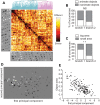Shape similarity, better than semantic membership, accounts for the structure of visual object representations in a population of monkey inferotemporal neurons
- PMID: 23950700
- PMCID: PMC3738466
- DOI: 10.1371/journal.pcbi.1003167
Shape similarity, better than semantic membership, accounts for the structure of visual object representations in a population of monkey inferotemporal neurons
Abstract
The anterior inferotemporal cortex (IT) is the highest stage along the hierarchy of visual areas that, in primates, processes visual objects. Although several lines of evidence suggest that IT primarily represents visual shape information, some recent studies have argued that neuronal ensembles in IT code the semantic membership of visual objects (i.e., represent conceptual classes such as animate and inanimate objects). In this study, we investigated to what extent semantic, rather than purely visual information, is represented in IT by performing a multivariate analysis of IT responses to a set of visual objects. By relying on a variety of machine-learning approaches (including a cutting-edge clustering algorithm that has been recently developed in the domain of statistical physics), we found that, in most instances, IT representation of visual objects is accounted for by their similarity at the level of shape or, more surprisingly, low-level visual properties. Only in a few cases we observed IT representations of semantic classes that were not explainable by the visual similarity of their members. Overall, these findings reassert the primary function of IT as a conveyor of explicit visual shape information, and reveal that low-level visual properties are represented in IT to a greater extent than previously appreciated. In addition, our work demonstrates how combining a variety of state-of-the-art multivariate approaches, and carefully estimating the contribution of shape similarity to the representation of object categories, can substantially advance our understanding of neuronal coding of visual objects in cortex.
Conflict of interest statement
The authors have declared that no competing interests exist.
Figures






References
-
- Logothetis NK, Sheinberg DL (1996) Visual object recognition. Ann Rev Neurosci 19: 577–621. - PubMed
-
- Tanaka K (1996) Inferotemporal cortex and object vision. Annual Review of Neuroscience 19: 109–139. - PubMed
-
- Rolls ET (2000) Functions of the primate temporal lobe cortical visual areas in invariant visual object and face recognition. Neuron 27: 205–218. - PubMed
-
- Connor CE, Brincat SL, Pasupathy A (2007) Transformation of shape information in the ventral pathway. Current Opinion in Neurobiology 17: 140–147. - PubMed
-
- Orban GA (2008) Higher Order Visual Processing in Macaque Extrastriate Cortex. Physiological Reviews 88: 59. - PubMed
Publication types
MeSH terms
Grants and funding
LinkOut - more resources
Full Text Sources
Other Literature Sources

